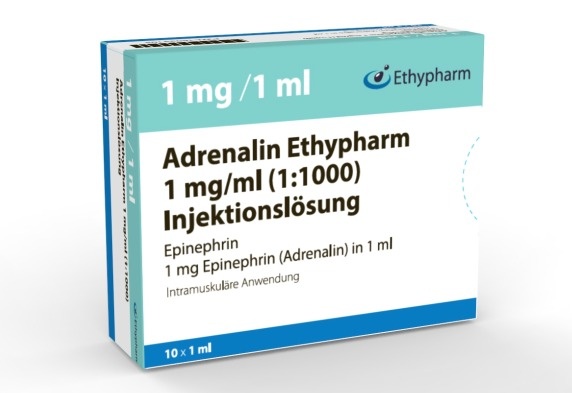

ADRENALINE ETHYPHARM 1 mg/mL INJECTABLE SOLUTION

Ask a doctor about a prescription for ADRENALINE ETHYPHARM 1 mg/mL INJECTABLE SOLUTION

How to use ADRENALINE ETHYPHARM 1 mg/mL INJECTABLE SOLUTION
Introduction
Package Leaflet: Information for the User
Adrenaline Ethypharm 1 mg/ml Solution for Injection
Epinephrine
Read all of this leaflet carefully before you start using this medicine because it contains important information for you.
- Keep this leaflet, you may need to read it again. If you have any further questions, ask your doctor or pharmacist.
- This medicine has been prescribed for you only. Do not pass it on to others. It may harm them, even if their signs of illness are the same as yours.
- If you get any side effects, talk to your doctor, pharmacist or nurse. This includes any possible side effects not listed in this leaflet. See section 4.
Contents of the pack and other information
- What Adrenaline Ethypharm is and what it is used for
- What you need to know before Adrenaline Ethypharm is administered
- How Adrenaline Ethypharm is used
- Possible side effects
- Storage of Adrenaline Ethypharm
- Contents of the pack and further information
1. What Adrenaline Ethypharm is and what it is used for
Adrenaline belongs to a group of medicines known as sympathomimetic agents.
Adrenaline injection may be used for the emergency treatment of severe allergic reactions or cardiac arrest.
2. What you need to know before Adrenaline Ethypharm is administered
Do not use Adrenaline Ethypharm if:
- you are allergic (hypersensitive) to adrenaline or any of the other ingredients of this medicine (listed in section 6).
- Adrenaline injections should not be applied to areas such as the fingers of the hands or feet, ears, nose, genitals or buttocks, as this could affect blood flow to these areas.
Warnings and precautions
Consult your doctor, pharmacist or nurse before using Adrenaline Ethypharm if:
- you are elderly
- you have any heart problems, especially if they affect your heart rate or you suffer from chest pain
- you have brain problems, such as stroke, brain damage or vascular disease
- you have an overactive thyroid, diabetes or glaucoma (high pressure in the eye)
- you have a phaeochromocytoma (a tumour of the adrenal gland)
- you have low potassium levels in the blood or high calcium levels in the blood
- you have a tumour in the prostate gland or kidney disease
- you are in shock or have lost a lot of blood
- you are going to undergo surgery with general anaesthesia
- you suffer from high blood pressure
- you have arteriosclerosis, i.e. narrowing and hardening of the blood vessels in the body (your doctor may advise you)
If you or your child suffers from any of the above conditions, inform your doctor before this medicine is administered.
Other medicines and Adrenaline Ethypharm
Tell your doctor or nurse if you are taking, have recently taken or might take any other medicines, including those without a prescription.
Many medicines can interact with Adrenaline Ethypharm and greatly alter its effects. These include:
- monoamine oxidase inhibitors (MAOIs) or tricyclic antidepressants such as imipramine or amitriptyline, used to treat depression
- cardiac glycosides such as digoxin, used for heart failure
- guanethidine, used for rapid control of blood pressure
- diuretics, such as hydrochlorothiazide or furosemide
- inhalation anaesthetics, such as halothane
- medicines to increase or decrease blood pressure, including beta-blockers, e.g. propranolol, atenolol, bisoprolol or phentolamine
- antidiabetics, such as insulin or oral hypoglycaemic agents (e.g. glipizide)
- aminophylline and theophylline (medicines to help you breathe)
- corticosteroids (medicines used to treat inflammatory conditions in the body, such as asthma or arthritis)
- antihistamines (e.g. diphenhydramine) for the treatment of allergies
- medicines used to treat mental illnesses, such as chlorpromazine, periciazine or fluphenazine
- medicines used to treat underactive thyroid gland
- oxytocin (used to induce labour at term and control bleeding after childbirth)
- cough and cold remedies (sympathomimetics)
If you are already taking one of these medicines, consult your doctor before Adrenaline Ethypharm is administered.
Pregnancy and breast-feeding
If you are pregnant or breast-feeding, think you may be pregnant or are planning to have a baby, ask your doctor or pharmacist for advice before using this medicine.
Adrenaline should only be used during pregnancy and breast-feeding if your doctor considers it essential.
Driving and using machines
You should not drive or use machines if you have been administered Adrenaline Ethypharm.
Adrenaline Ethypharm contains sodium metabisulphite and sodium chloride
This medicine contains sodium metabisulphite, which may cause allergic-type reactions (hypersensitivity) in some people, leading to breathing difficulties or fainting. This is more likely to occur in people with a history of asthma or allergies (hypersensitivities).
This medicine contains less than 1mmol of sodium (23mg) per dose, i.e. it is essentially ‘sodium-free’.
3. How to use Adrenaline Ethypharm
Anaphylaxis
Your doctor will administer Adrenaline Ethypharm by intramuscular (IM) injection; however, in an emergency, it may be administered by intravenous (IV) injection.
Adrenaline injections should not be applied to areas such as the fingers of the hands or feet, ears, nose, genitals or buttocks, as this could affect blood flow to these areas. If repeated injections are required, your doctor should change the injection site.
It will be administered by a healthcare professional. Your doctor will decide the most suitable dose and route of administration for your specific case, based on your age and physical condition.
Adults
The usual dose is 0.5 ml. If necessary, this dose may be repeated several times at 5-minute intervals.
Elderly patients
There are no specific dosage regimens for adrenaline injection in elderly patients, although adrenaline should be used with extreme caution.
Paediatric population
The following doses of Adrenaline Ethypharm are recommended:
Age | Dose |
Over 12 years | 0.5 mg IM (0.5 ml of 1 mg/ml solution) 0.3 mg IM (0.3 ml of 1 mg/ml solution) in small or prepubescent children |
6-12 years | 0.3 mg IM (0.3 ml of 1 mg/ml solution) |
6 months-6 years | 0.15 mg IM (0.15 ml of 1 mg/ml solution) |
Up to 6 months | 0.01 mg/kg IM (0.01 ml/kg of 1 mg/ml solution) |
If necessary, these doses may be repeated several times at 5-15 minute intervals, depending on blood pressure, pulse and respiratory function.
A low-volume syringe should be used.
Cardiac arrest (cardiopulmonary resuscitation)
Adults
1 mg intravenously every 3-5 minutes.
Paediatric population
10 micrograms/kg intravenously or intraosseously. The maximum single dose is 1 mg.
If you think you have been given too much Adrenaline Ethypharm
In case of overdose or accidental ingestion, contact the Toxicology Information Service (telephone: 91 562 04 20) or consult your doctor or pharmacist. Bring this leaflet with you.
Since this medicine will be administered in a hospital, it is unlikely that you will be given too little or too much; however, talk to your doctor or nurse if you have any doubts.
4. Possible side effects
Like all medicines, Adrenaline Ethypharm can cause side effects, although not everybody gets them.
If you experience any of the following side effects, stop using the medicine and tell a doctor immediately:
- allergic reactions, although severe allergic reactions are rare
• difficulty breathing, swelling of the eyelids, face or lips, rash or itching (especially if it affects the whole body).
Other side effects (frequency unknown: cannot be estimated from the available data):
- headache
- dizziness
- feelings of anxiety, fear or agitation
- tremors
- insomnia, confusion, irritability
- abnormal behaviour or mood
- dry mouth or excessive saliva production
- weakness or sweating
- changes in heart rate and speed
- palpitations (rapid or irregular heartbeat), tachycardia (abnormally fast heart rate at rest), angina (chest pain of varying intensity)
- high blood pressure
- coldness of the upper or lower limbs
- shortness of breath
- reduced appetite, nausea or vomiting
- repeated injections may damage the tissues at the injection site,
- fluid retention
- metabolic acidosis (an imbalance of certain blood components) may occur
- cerebral haemorrhage
- paralysis of one side of the body
- increased blood sugar levels
- breakdown of body fat
- reduced potassium levels in the blood
- pulmonary oedema
- chest pain (acute angina)
- heart attack (acute myocardial infarction)
- pale appearance (pallor)
- fainting (syncope)
- dilation of the pupils (mydriasis)
In patients with Parkinson's disease, adrenaline may increase rigidity and tremors.
You may experience mild pain, bruising/bleeding or fluid residue at the injection site after administration of this medicine.
Reporting of side effects
If you get any side effects, talk to your doctor, pharmacist or nurse. This includes any possible side effects not listed in this leaflet. You can also report side effects directly via the Spanish Pharmacovigilance System for Human Use Medicines: www.notificaRAM.es. By reporting side effects, you can help provide more information on the safety of this medicine.
5. Storage of Adrenaline Ethypharm
Keep this medicine out of the sight and reach of children.
Do not use this medicine after the expiry date which is stated on the label after EXP. The expiry date refers to the last day of the month shown.
Store the ampoule in the outer packaging to protect it from light.
Do not store above 25°C. Do not freeze.
Once diluted, the ready-to-use solution should be administered as soon as possible.
Adrenaline Ethypharm should not be administered if it has already been used or shows visible signs of damage.
Medicines should not be disposed of via wastewater or household waste. Return any unused medicine to a pharmacy for proper disposal. Ask your pharmacist how to dispose of medicines no longer required. This will help protect the environment.
6. Container Content and Additional Information
Composition of Adrenalina Ethypharm
- The active ingredient is epinephrine (adrenaline) (as acid tartrate), 1 mg per ml.
- The other components are sodium chloride, sodium metabisulfite, and water for injection. Hydrochloric acid and sodium hydroxide may be added to adjust the acidity.
Appearance of the Product and Container Content
Adrenalina Ethypharm is a clear, colorless solution supplied in a package with 10 glass ampoules, each containing 0.5, 1, 2, 5, or 10 ml.
Only some package sizes may be marketed.
Marketing Authorization Holder and Manufacturer:
Marketing Authorization Holder:
Ethypharm
194 Bureaux de la Colline, Bâtiment D
92213 Saint-Cloud CEDEX
France
Manufacturer:
ETHYPHARM,
Chemin de la Poudriere, GRAND QUEVILLY, 76120, France
Or
ETHYPHARM,
Zone Industrielle de Saint-Arnoult, CHATEAUNEUF EN THYMERAIS,
28170, France
This medicinal product is authorized in the EEA Member States under the following names:
Spain | Adrenalina Ethypharm 1 mg/ml solution for injection |
Finland | Adrenalin Ethypharm 1 mg/ml injektioneste, liuos |
Germany | Adrenaline Ethypharm 1 mg/ml (1:1000) Injektionslösung |
Denmark | Adrenalin Ethypharm 1 mg/ml (1:1000) injektionsvæske, opløsning |
Norway | Adrenalin Ethypharm 1 mg/ml injeksjonsvæske, oppløsning |
Sweden | Adrenalin Ethypharm 1 mg/ml (1:1000) injektionsvätska, lösning |
Date of the Last Revision of this Leaflet:July 2024
Other Sources of Information
Detailed information on this medicinal product is available on the website of the Spanish Agency for Medicines and Health Products (AEMPS) http://www.aemps.gob.es/.
The following information is intended for healthcare professionals only:
Preparation and Handling:
Do not use Adrenalina Ethypharm 1mg/ml solution for injection if you detect that it has discolored.
Repeated local administration may cause necrosis at the injection site.
The best point for intramuscular injection is in the anterolateral area, in the central third of the thigh. The needle used for the injection should be long enough to ensure that the adrenaline reaches the muscle.
Intramuscular injection in the fingers of the hands and feet, ears, nose, genitals, or buttocks should be avoided due to the risk of tissue necrosis.
Prolonged administration may cause metabolic acidosis, renal necrosis, or tachyphylaxis.
The use of adrenaline injections should be avoided or carried out with extreme caution in patients undergoing general anesthesia with halothane or other halogenated anesthetics, due to the risk of developing ventricular fibrillation.
Do not mix with other medicines unless compatibility has been confirmed.
Adrenaline injections should not be used during the second stage of labor.
An accidental intravascular injection can lead to cerebral hemorrhage due to a sudden increase in blood pressure.
The patient should be monitored as soon as possible (heart rate, blood pressure, ECG, pulse oximetry) to evaluate the response to adrenaline.
Incompatibilities
Adrenaline/epinephrine is rapidly denatured by oxidizing agents and alkalines, including sodium bicarbonate, halogens, nitrates, nitrites, and salts of iron, copper, and zinc.
Dilution
For intravenous administration, Adrenalina Ethypharm should be diluted to a solution of 0.1 mg/ml (a 1:10 dilution of the ampoule content) with 0.9% sodium chloride.
Dosage and Administration
Anaphylaxis
Adrenalina Ethypharm is intended for intramuscular use.
Do not administer Adrenalina Ethypharm 1mg/ml intravenously without dilution.
The administration of adrenaline intravenously for the treatment of anaphylaxis requires the use of an adrenaline solution of 0.1mg/ml.
The intramuscular route is generally preferred in the initial treatment of anaphylaxis; the intravenous route is generally more appropriate in the Intensive Care Unit or in the Emergency Department environment. Adrenalina Ethypharm 1mg/ml is not suitable for intravenous use. If adrenaline 0.1 mg/ml is not available, Adrenalina Ethypharm should be diluted to 0.1 mg/ml (1:10000) before intravenous use. The intravenous route for adrenaline injection should be used with extreme caution and is best reserved for specialists familiar with the intravenous use of adrenaline.
The intramuscular route is the preferred route of administration for most people who need treatment with adrenaline in the event of acute anaphylaxis.
The usual dose for adults is 0.5 mg (0.5 ml of adrenaline 1 mg/ml). If necessary, this dose may be repeated several times at 5-minute intervals depending on blood pressure, pulse, and respiratory function.
Elderly Patients:
There are no established dosage regimens for adrenaline injections in elderly patients. However, in these patients, adrenaline should be used with extreme caution, as they may be more prone to experiencing the adverse cardiovascular effects of adrenaline.
Pediatric Population
The following doses of Adrenalina Ethypharm are recommended:
Age | Dose |
Over 12 years | 0.5 mg IM (0.5ml of 1 mg/ml solution) 0.3 mg IM (0.3ml of 1 mg/ml solution) in small or prepubescent children |
6-12 years | 0.3 mg IM (0.3 ml of 1 mg/ml solution) |
6 months-6 years | 0.15 mg IM (0.15 ml of 1 mg/ml solution) |
Up to 6 months | 0.01 mg/kg IM (0.01ml/kg of 1 mg/ml solution) |
When the patient is in a critical state and there is a real doubt about the sufficiency of circulation and absorption from the injection site, Adrenalina Ethypharm may be administered by intravenous injection (i.v.).
Intravenous adrenaline should only be administered by persons experienced in the use and adjustment of vasopressors in their clinical practice (see section 4.4 of FT). In the case of intravenous adrenaline, the dose should be adjusted with boluses of 50 micrograms based on the response. This dose can only be administered with a 0.1 mg/ml solution (i.e., a 1:10 ml dilution of the ampoule content). The undiluted adrenaline solution of 1 mg/ml should not be administered intravenously.
In case of repeated doses of adrenaline, it is recommended to administer an intravenous infusion of adrenaline with adjustment of the rate based on the response in the presence of continuous hemodynamic monitoring.
Cardiopulmonary Resuscitation
Adults
1 mg of adrenaline intravenously repeated every 3-5 minutes.
If injected through a peripheral vein, it should be followed by flushing with at least 20 ml of 0.9% sodium chloride for injection (to facilitate the arrival of the medication in the central circulation).
If venous access is not available, intraosseous administration is recommended.
Pediatric Population
The recommended intravenous or intraosseous dose of adrenaline in children is 10 micrograms/kg. Depending on the weight, this dose may need to be administered with a 0.1 mg/ml solution (i.e., a 1:10 ml dilution of the ampoule content). Additional doses of adrenaline may be administered every 3-5 minutes. The maximum single dose is 1 mg.
If necessary, these doses may be repeated several times at 5-15 minute intervals based on blood pressure, pulse, and respiratory function.
A low-volume syringe should be used.
Elimination
Unused medicinal products and waste should be disposed of in accordance with local regulations.
Overdose
Signs:
An overdose of Adrenalina Ethypharm causes severe hypertension. As a result, cerebral, cardiac, or vascular accidents may occur with potentially fatal consequences (cerebral hemorrhage, arrhythmias such as transient bradycardia followed by tachycardia, which may lead to arrhythmia, myocardial necrosis, acute pulmonary edema, or renal failure).
Treatment
The effects of adrenaline can be counteracted, depending on the patient's condition, by administering rapid-acting vasodilators, rapid-acting alpha-adrenergic receptor antagonists (e.g., phentolamine), or beta-adrenergic receptor antagonists (e.g., propranolol). However, due to the short half-life of adrenaline, it may not be necessary to treat with these medications. In case of prolonged hypotensive reactions, it may be necessary to administer another vasopressor agent, such as noradrenaline.
- Country of registration
- Availability in pharmaciesSupply issue reported
- Active substance
- Prescription requiredYes
- Manufacturer
- This information is for reference only and does not constitute medical advice. Always consult a licensed doctor before taking any medication. Oladoctor is not responsible for medical decisions based on this content.
- Alternatives to ADRENALINE ETHYPHARM 1 mg/mL INJECTABLE SOLUTIONDosage form: INJECTABLE, 1 mg/10 mlActive substance: epinephrineManufacturer: Laboratoire AguettantPrescription requiredDosage form: INJECTABLE, Epinephrine base 1 mg/mlActive substance: epinephrineManufacturer: B Braun Medical S.A.Prescription requiredDosage form: INJECTABLE, 1 mg/mlActive substance: epinephrineManufacturer: Laboratorios Basi Industria Farmaceutica S.A.Prescription required
Alternatives to ADRENALINE ETHYPHARM 1 mg/mL INJECTABLE SOLUTION in other countries
The best alternatives with the same active ingredient and therapeutic effect.
Alternative to ADRENALINE ETHYPHARM 1 mg/mL INJECTABLE SOLUTION in Poland
Alternative to ADRENALINE ETHYPHARM 1 mg/mL INJECTABLE SOLUTION in Ukraine
Online doctors for ADRENALINE ETHYPHARM 1 mg/mL INJECTABLE SOLUTION
Discuss dosage, side effects, interactions, contraindications, and prescription renewal for ADRENALINE ETHYPHARM 1 mg/mL INJECTABLE SOLUTION – subject to medical assessment and local rules.










